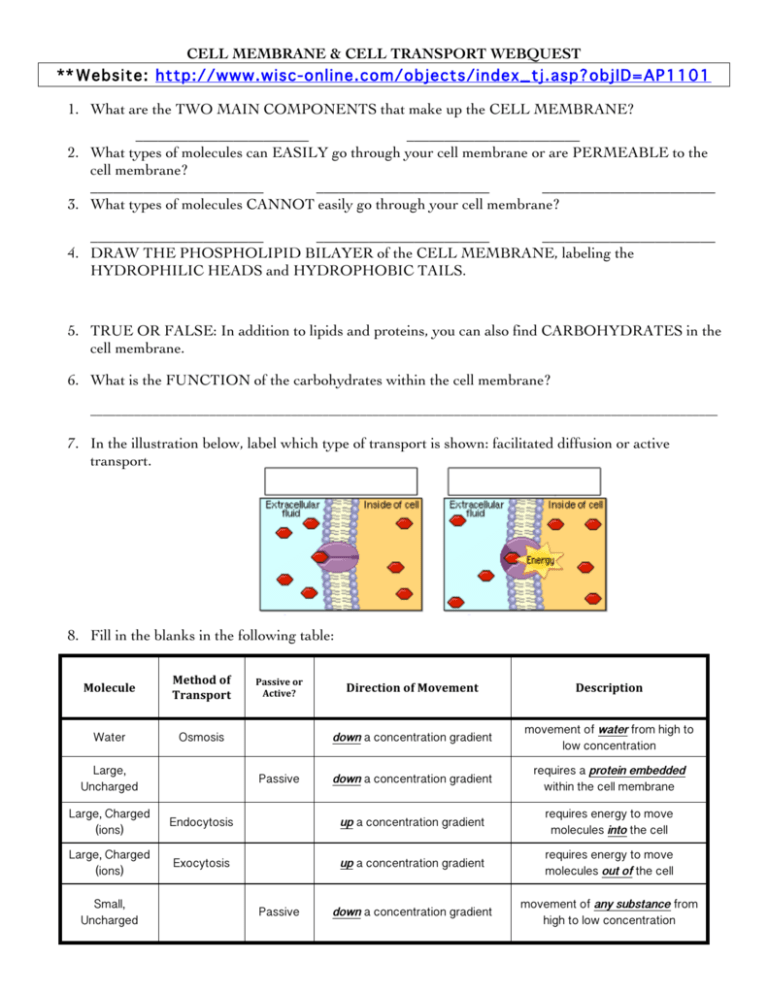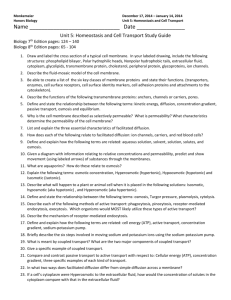CELL MEMBRANE & CELL TRANSPORT WEBQUEST ** Website
advertisement

CELL MEMBRANE & CELL TRANSPORT WEBQUEST ** W ebsite: http://www.wisc-online.com/objects/index_tj.asp?objID=AP1101 1. What are the TWO MAIN COMPONENTS that make up the CELL MEMBRANE? _______________________ _______________________ 2. What types of molecules can EASILY go through your cell membrane or are PERMEABLE to the cell membrane? _______________________ _______________________ _______________________ 3. What types of molecules CANNOT easily go through your cell membrane? _______________________ _______________________ _______________________ 4. DRAW THE PHOSPHOLIPID BILAYER of the CELL MEMBRANE, labeling the HYDROPHILIC HEADS and HYDROPHOBIC TAILS. 5. TRUE OR FALSE: In addition to lipids and proteins, you can also find CARBOHYDRATES in the cell membrane. 6. What is the FUNCTION of the carbohydrates within the cell membrane? ____________________________________________________________________________________________________ 7. In the illustration below, label which type of transport is shown: facilitated diffusion or active transport. 8. Fill in the blanks in the following table: Molecule Method of Transport Water Osmosis Large, Uncharged Passive or Active? Passive Direction of Movement Description down a concentration gradient movement of water from high to low concentration down a concentration gradient requires a protein embedded within the cell membrane Large, Charged (ions) Endocytosis up a concentration gradient requires energy to move molecules into the cell Large, Charged (ions) Exocytosis up a concentration gradient requires energy to move molecules out of the cell down a concentration gradient movement of any substance from high to low concentration Small, Uncharged Passive CELL MEMBRANE & CELL TRANSPORT WEBQUEST **Website: http://programs.northlandcollege.edu/biology/Biology1111/animations/transport1.html Select PASSIVE TRANSPORT 9. Define PASSIVE TRANSPORT: ____________________________________________________________________________________________________ 10. What are three types of PASSIVE TRANSPORT? _______________________ _______________________ _______________________ PRESS “NEXT” 11. What is the function of INTERGRAL PROTEINS? ____________________________________________________________________________________________________ 12. Cell Membranes are said to be SEMIPERMEABLE, what does that mean? ____________________________________________________________________________________________________ PRESS “NEXT” 13. Define diffusion. ____________________________________________________________________________________________________ 14. Define a CONCENTRATION GRADIENT: ____________________________________________________________________________________________________ 15. ILLUSTRATE a “before” and “after” example of diffusion across a cell membrane: BEFORE AFTER 16. Identify THREE factors that can have an affect on the RATE of DIFFUSION: _______________________ _______________________ 17. What is meant by the term EQUILIBRIUM? _______________________ ____________________________________________________________________________________________________ 18. DRAW a PICTURE showing a CELL that is IN EQUILIBRIUM with its environment: PRESS “NEXT” 19. Define facilitated diffusion: ____________________________________________________________________________________________________ 20. Does facilitated diffusion require energy for the cell? _________ 21. What molecules within the cell membrane play a VITAL ROLE in FACILITATED DIFFUSION? ____________________________________________________________________________________________________ CELL MEMBRANE & CELL TRANSPORT WEBQUEST PRESS “NEXT” 22. Define osmosis: ____________________________________________________________________________________________________ 23. Draw a BEFORE and AFTER for a cell in a HYPOTONIC solution. Show the change in size of the cell. 24. Draw a BEFORE and AFTER for a cell in a HYPERTONIC solution. Show the change in size of the cell. **WEBSITE: http://www.vivo.colostate.edu/hbooks/cmb/cells/pmemb/osmosis.html Scroll down to “The classic demonstration of osmosis and osmotic pressure is to immerse red blood cells in solutions of varying osmolarity and watch what happens.” 25. DRAW what a Red Blood Cell would look like in an ISOTONIC SOLUTION. 26. DRAW what a Red Blood Cell would look like in a HYPERTONIC SOLUTION. 27. DRAW what a Red Blood Cell would look like in a HYPOTONIC SOLUTION. **WEBSITE: http://www.indiana.edu/~phys215/lecture/lecnotes/Old%20Files/diff.html 28. Diffusion ALWAYS goes from ______________concentration to __________________concentration and DOES or DOES NOT require energy in the form of ATP. 29. At the beginning of the animation, where are there more particles? __________________ 30. Are the particles moving in only one direction, or are they moving in both directions? _____________ 31. Watch the animation until it reaches NO NET FLOW. How many particles are on each side of the membrane? _______ 32. When there is NO NET FLOW the cell is said to reach what? ___________________ CELL MEMBRANE & CELL TRANSPORT WEBQUEST **WEBSITE #5: http://nhscience.lonestar.edu/biol/osotutor.html 33. EXPLAIN why food-coloring particles are FIRST condensed into a single drop, but after revisiting the cup of water several minutes later, the entire cup of water is colored. ____________________________________________________________________________________________________ ____________________________________________________________________________________________________ CLICK ON ANIMAL CELL MEMBRANE TUTORIAL – Animal Cell Membrane Tutorial - Page 1 of 3 34. The plasma is a(an)_____________solution to the solution in the red blood cell. 35. The diffusion of water(osmosis) into the cell is _________the diffusion of water(osmosis)out of the cell. 36. The turgor pressure of the RBC is _________zero. 37. The pressure on the inside of the cell is ___________ the pressure on the outside. NOW, CLICK ON “NEXT” at the BOTTOM of the page – Animal Cell Membrane Tutorial - Page 2 of 3 38. This red blood cell can now be described as being ________________. 39. The % concentration of water in the cell was _____________the % concentration of water in the salt solution. 40. Thus the net direction of osmosis was ______________ the red blood cell. 41. The salt solution was _______________ relative to the red blood cell. NOW, CLICK ON “NEXT” at the BOTTOM of the page. – Animal Cell Membrane Tutorial - Page 3 of 3 42. This red blood cell can now be described as being________________. 43. The distilled water was _________________ relative to the cell. 44. The cell was ________________ relative to the distilled water. 45. The direction of net osmosis was __________________ the cell. EXTRA CREDIT (3 points): Explain what is happening in this cartoon.









